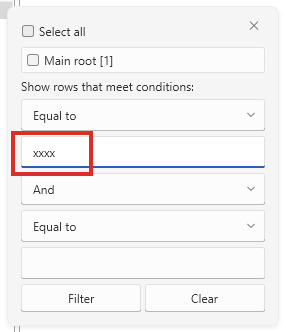ArgumentException occurs when using the voice typing feature of Windows (started with the Windows Key + H key combo) to convert speech to text in RadRichTextBox.
Exception stacktrace:
System.ArgumentException: 'Requested distance is outside the content of the associated document.'PresentationFramework.dll!System.Windows.Documents.TextPointer.TextPointer(System.Windows.Documents.TextContainer textContainer, int offset, System.Windows.Documents.LogicalDirection direction) PresentationFramework.dll!System.Windows.Documents.TextContainer.CreatePointerAtOffset(int offset, System.Windows.Documents.LogicalDirection direction) PresentationFramework.dll!System.Windows.Documents.TextParentUndoUnit.Do() PresentationFramework.dll!MS.Internal.Documents.UndoManager.Redo(int count) PresentationFramework.dll!System.Windows.Documents.TextStore.RedoQuietly(int count) PresentationFramework.dll!System.Windows.Documents.TextStore.SetFinalDocumentState(MS.Internal.Documents.UndoManager undoManager, System.Collections.Stack imeChangeStack, int appChangeCount, int imeSelectionAnchorOffset, int imeSelectionMovingOffset, int appSelectionAnchorOffset, int appSelectionMovingOffset) PresentationFramework.dll!System.Windows.Documents.TextStore.HandleCompositionEvents(int previousUndoCount) PresentationFramework.dll!System.Windows.Documents.TextStore.GrantLockWorker(MS.Win32.UnsafeNativeMethods.LockFlags flags) PresentationFramework.dll!System.Windows.Documents.TextStore.RequestLock(MS.Win32.UnsafeNativeMethods.LockFlags flags, out int hrSession)
FormatException is thrown during the import of a table coming from a docx document when the application culture is "sv-SE". This happens when the column width in the document is a floating point number (ex: 120.65). The Swedish culture uses "," as decimal separator and " " as the number group separator, which makes any invariant decimal value (like 120.65) invalid during standard parsing (ex: float.Parse("120.65")).
Stacktrace:
FormatException: The input string '4514.5' was not in the correct format. at System.Single.Parse(String s) Telerik.Windows.Controls.RichTextBox.dll!Telerik.Windows.Documents.FormatProviders.OpenXml.Docx.Import.TableImporter.ImportTableGrid(Telerik.Windows.Documents.FormatProviders.OpenXml.Docx.Parsing.Style style) Telerik.Windows.Controls.RichTextBox.dll!Telerik.Windows.Documents.FormatProviders.OpenXml.Docx.Import.TableImporter.Import(Telerik.Windows.Documents.FormatProviders.OpenXml.Docx.Parsing.Style parentStyle) Telerik.Windows.Controls.RichTextBox.dll!Telerik.Windows.Documents.FormatProviders.OpenXml.Docx.Import.MainDocumentImporter.BuildTable(Telerik.Windows.Documents.FormatProviders.OpenXml.Docx.Parsing.Style parentStyle) Telerik.Windows.Controls.RichTextBox.dll!Telerik.Windows.Documents.FormatProviders.OpenXml.Docx.Import.MainDocumentImporter.BuildBody() Telerik.Windows.Controls.RichTextBox.dll!Telerik.Windows.Documents.FormatProviders.OpenXml.Docx.Import.MainDocumentImporter.BuildDocument() Telerik.Windows.Controls.RichTextBox.dll!Telerik.Windows.Documents.FormatProviders.OpenXml.Docx.Import.MainDocumentImporter.Import()Telerik.Windows.Controls.RichTextBox.dll!Telerik.Windows.Documents.FormatProviders.OpenXml.Docx.Import.DocxImporter.ReadXmlContentFromPackage(Telerik.Windows.Documents.FormatProviders.OpenXml.Docx.Import.DocxPartImporterBase importer) Telerik.Windows.Controls.RichTextBox.dll!Telerik.Windows.Documents.FormatProviders.OpenXml.Docx.Import.DocxImporter.ReadXmlContentAndRelationsFromPackage(Telerik.Windows.Documents.FormatProviders.OpenXml.Docx.Import.DocxPartImporterBase importer) Telerik.Windows.Controls.RichTextBox.dll!Telerik.Windows.Documents.FormatProviders.OpenXml.Docx.Import.DocxImporter.Import() Telerik.Windows.Controls.RichTextBox.dll!Telerik.Windows.Documents.FormatProviders.OpenXml.Docx.DocxFormatProvider.Import(System.IO.Stream input)
To work this around, switch to InvariantCulture during the import and return the original culture after that.
var cultureCache = Thread.CurrentThread.CurrentCulture;
Thread.CurrentThread.CurrentCulture = System.Globalization.CultureInfo.InvariantCulture;
Thread.CurrentThread.CurrentUICulture = System.Globalization.CultureInfo.InvariantCulture;
var provider= new DocxFormatProvider();
rtb.Document = provider.Import(stream);
Thread.CurrentThread.CurrentCulture = cultureCache;
Thread.CurrentThread.CurrentUICulture = cultureCache;
We can improve the animation applied to the thumb for the mouse-over state to take into account the values of the ThumbWidth/ThumbHeight and properties.
For example, typing the combination to display the "단" character, pressing the "ㅊ" character, will display the autocomplete for items that contain it; however, pressing another key to create a combination representing the "체" causes the "ㅊ" to be omitted, and only the "ㅔ" is displayed.
"(hello)"
In the example above, if you double click on the word "hello", this should select only the word. However, it selects also the opening bracket. The final selection becomes "(hello".
Note that the issue occurs also if you click in the end of the word "hello" and use Ctrl+Shift+LeftArrow to select it to the beginning.
Steps to reproduce:
1. Click filter icon in column
2. Enter invalid value in filter input
3. Press Filter, the value gets underlined, suggesting some kind of error.

4. Click the place marked 1 and then 2.
This time, it seems a message appears about the cause of the error, but it doesn’t fit inside the control.

For the Spanish culture, some of the localization strings are for the German culture.
The following resource keys are the ones containing wrong values:
- PivotInlineFieldList_ValuesEmptyText
- PivotInlineFieldList_RowsEmptyText
- PivotInlineFieldList_ColumnsEmptyText
- PivotInlineFieldList_FiltersEmptyText
- Pivot_AggregateSum
- PivotFieldList_SetSumAggregate
- PivotFieldList_Top10Sum
- PivotFieldList_StringFormatDescription
To work around this, you could introduce a custom LocalizationManager and override the GetStringOverride method.
More information about this suggestion can be found here.
One of the following two exceptions occur when the BindingOperations.EnableCollectionSynchronization() is used with the ItemsSource of RadTreeListView:
- System.InvalidOperationException: 'Collection was modified; enumeration operation may not execute.'
- System.NullReferenceException: 'Object reference not set to an instance of an object.'
When using the EnableCollectionSynchronization, the corresponding items control should allow updates of the ItemsSource collection on different threads. This is valid if the requirements to use the EnableCollectionSynchronization method are met.
The exception stack traces are:
InvalidOperationException
at System.ThrowHelper.ThrowInvalidOperationException_InvalidOperation_EnumFailedVersion() in /_/src/libraries/System.Private.CoreLib/src/System/ThrowHelper.cs:line 432
at System.Collections.Generic.List`1.Enumerator.MoveNext() in /_/src/libraries/System.Private.CoreLib/src/System/Collections/Generic/List.cs:line 1130
at System.Linq.Enumerable.SelectEnumerableIterator`2.MoveNext()
at Telerik.Windows.Data.EnumerableExtensions.<SelectRecursive>d__15`1.MoveNext()
at System.Linq.Enumerable.SelectEnumerableIterator`2.MoveNext()
at Telerik.Windows.Data.HierarchicalCollectionViewBase.PopulateInternalList(IQueryable view)
at Telerik.Windows.Data.QueryableCollectionView.get_InternalList()
at Telerik.Windows.Data.HierarchicalCollectionViewBase.get_InternalCount()
at Telerik.Windows.Data.DataItemCollection.get_Item(Int32 index)
at Telerik.Windows.Controls.GridView.Rows.GetRowItemsAtRange(Int32 startIndex, Int32 endIndex)
at Telerik.Windows.Controls.GridView.GridViewVirtualizingPanel.FlatLayoutStrategy.RealizeRows(Int32 startIndex, Int32 endIndex, Double& verticalOffset, HashSet`1& realizedRows)
at Telerik.Windows.Controls.GridView.GridViewVirtualizingPanel.FlatLayoutStrategy.MeasureOverride(Size availableSize)
at Telerik.Windows.Controls.GridView.GridViewVirtualizingPanel.MeasureOverride(Size availableSize)NullReferenceException at Telerik.Windows.Data.QueryableCollectionView.InternalGetItemAt(Int32 index) in Telerik.Windows.Data\QueryableCollectionView.cs:line 3081 at Telerik.Windows.Controls.GridView.Rows.GetRowItemsAtRange(Int32 startIndex, Int32 endIndex) at Telerik.Windows.Controls.GridView.GridViewVirtualizingPanel.FlatLayoutStrategy.RealizeRows(Int32 startIndex, Int32 endIndex, Double& verticalOffset, HashSet`1& realizedRows) at Telerik.Windows.Controls.GridView.GridViewVirtualizingPanel.FlatLayoutStrategy.MeasureOverride(Size availableSize) at Telerik.Windows.Controls.GridView.GridViewVirtualizingPanel.MeasureOverride(Size availableSize)
To work this around dispatch the updates of the ItemsSource collection to the main UI thread.
Dispatcher.BeginInvoke(new Action(() =>
{
// add/remove items from the source collection
}));RichTextBox: Bullet list with several levels is not viewed correctly in WordPad.
In Word, this works as expected. When the document is imported into RadRichTextBox, this works as well.


